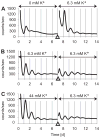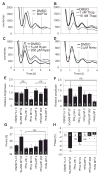Fibroblast circadian rhythms of PER2 expression depend on membrane potential and intracellular calcium
- PMID: 22734566
- PMCID: PMC3491983
- DOI: 10.3109/07420528.2012.679330
Fibroblast circadian rhythms of PER2 expression depend on membrane potential and intracellular calcium
Abstract
The suprachiasmatic nucleus (SCN) of the hypothalamus synchronizes circadian rhythms of cells and tissues throughout the body. In SCN neurons, rhythms of clock gene expression are suppressed by manipulations that hyperpolarize the plasma membrane or lower intracellular Ca(2+). However, whether clocks in other cells also depend on membrane potential and calcium is unknown. In this study, the authors investigate the effects of membrane potential and intracellular calcium on circadian rhythms in mouse primary fibroblasts. Rhythms of clock gene expression were monitored using a PER2::LUC knockin reporter. Rhythms were lost or delayed at lower (hyperpolarizing) K(+) concentrations. Bioluminescence imaging revealed that this loss of rhythmicity in cultures was due to loss of rhythmicity of single cells rather than loss of synchrony among cells. In lower Ca(2+) concentrations, rhythms were advanced or had shorter periods. Buffering intracellular Ca(2+) by the calcium chelator 1,2-Bis(2-aminophenoxy)ethane-N,N,N',N'-tetraacetic acid tetrakis acetoxymethyl ester (BAPTA-AM) or manipulation of inositol triphosphate (IP(3))-sensitive intracellular calcium stores by thapsigargin delayed rhythms. These results suggest that the circadian clock in fibroblasts, as in SCN neurons, is regulated by membrane potential and Ca(2+). Changes in intracellular Ca(2+) may mediate the effects of membrane potential observed in this study.
Conflict of interest statement
Figures






Similar articles
-
Calcium Circadian Rhythmicity in the Suprachiasmatic Nucleus: Cell Autonomy and Network Modulation.eNeuro. 2017 Aug 18;4(4):ENEURO.0160-17.2017. doi: 10.1523/ENEURO.0160-17.2017. eCollection 2017 Jul-Aug. eNeuro. 2017. PMID: 28828400 Free PMC article.
-
Dual origins of the intracellular circadian calcium rhythm in the suprachiasmatic nucleus.Sci Rep. 2017 Feb 3;7:41733. doi: 10.1038/srep41733. Sci Rep. 2017. PMID: 28155916 Free PMC article.
-
IA Channels Encoded by Kv1.4 and Kv4.2 Regulate Circadian Period of PER2 Expression in the Suprachiasmatic Nucleus.J Biol Rhythms. 2015 Oct;30(5):396-407. doi: 10.1177/0748730415593377. Epub 2015 Jul 6. J Biol Rhythms. 2015. PMID: 26152125 Free PMC article.
-
Calcium dynamics and circadian rhythms in suprachiasmatic nucleus neurons.Neuroscientist. 2004 Aug;10(4):315-24. doi: 10.1177/10738584031262149. Neuroscientist. 2004. PMID: 15271259 Review.
-
Encoding the ins and outs of circadian pacemaking.J Biol Rhythms. 2006 Dec;21(6):470-81. doi: 10.1177/0748730406294316. J Biol Rhythms. 2006. PMID: 17107937 Review.
Cited by
-
A simple method using ex vivo culture of hair follicle tissue to investigate intrinsic circadian characteristics in humans.Sci Rep. 2017 Jul 28;7(1):6824. doi: 10.1038/s41598-017-07268-8. Sci Rep. 2017. PMID: 28755004 Free PMC article.
-
Lithium effects on circadian rhythms in fibroblasts and suprachiasmatic nucleus slices from Cry knockout mice.Neurosci Lett. 2016 Apr 21;619:49-53. doi: 10.1016/j.neulet.2016.02.030. Epub 2016 Feb 27. Neurosci Lett. 2016. PMID: 26930624 Free PMC article.
-
A Method for Culturing Mouse Whisker Follicles to Study Circadian Rhythms ex vivo.Bio Protoc. 2019 Jan 20;9(2):e3148. doi: 10.21769/BioProtoc.3148. eCollection 2019 Jan 20. Bio Protoc. 2019. PMID: 33654893 Free PMC article.
-
Cardiomyocyte Circadian Oscillations Are Cell-Autonomous, Amplified by β-Adrenergic Signaling, and Synchronized in Cardiac Ventricle Tissue.PLoS One. 2016 Jul 26;11(7):e0159618. doi: 10.1371/journal.pone.0159618. eCollection 2016. PLoS One. 2016. PMID: 27459195 Free PMC article.
-
Emerging Roles of the Membrane Potential: Action Beyond the Action Potential.Front Physiol. 2018 Nov 21;9:1661. doi: 10.3389/fphys.2018.01661. eCollection 2018. Front Physiol. 2018. PMID: 30519193 Free PMC article. Review.
References
-
- Baxter DF, Kirk M, Garcia AF, Raimondi A, Holmqvist MH, Flint KK, Bojanic D, Distefano PS, Curtis R, Xie Y. A novel membrane potential-sensitive fluorescent dye improves cell-based assays for ion channels. J Biomol Screen. 2002;7:79–85. - PubMed
-
- Chilton L, Ohya S, Freed D, George E, Drobic V, Shibukawa Y, Maccannell KA, Imaizumi Y, Clark RB, Dixon IM, Giles WR. K+ currents regulate the resting membrane potential, proliferation, and contractile responses in ventricular fibroblasts and myofibroblasts. Am J Physiol Heart Circ Physiol. 2005;288:H2931–2939. - PubMed
Publication types
MeSH terms
Substances
Grants and funding
LinkOut - more resources
Full Text Sources
Miscellaneous
